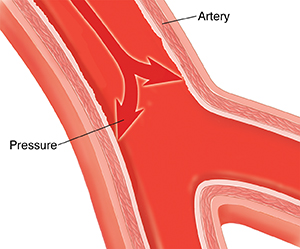High Blood Pressure and Peripheral Arterial Disease (PAD)
High Blood Pressure and Peripheral Arterial Disease (PAD)
Blood pressure measures the force of blood against your artery walls. High blood pressure (hypertension) can harm your arteries. It also puts you at risk for peripheral arterial disease (PAD). PAD is a disease of arteries in the legs. If you have PAD, it’s likely that arteries in other parts of your body are diseased, too. That puts you at high risk for heart attack and other heart diseases. Read on to learn how high blood pressure can lead to PAD and affect your health.
High blood pressure defined
Your blood pressure is too high if it is 130/80 mmHg or higher.
How can high blood pressure lead to peripheral arterial disease?
Having high blood pressure makes it easier for plaque to form. Plaque is a waxy material made up of cholesterol and other things. It can build up in your artery walls. As plaque builds up, your arteries can become narrowed. This limits blood flow. If high blood pressure isn’t controlled, you are more likely to have PAD and other heart problems. But high blood pressure can be controlled with exercise, weight loss, dietary changes, and medicine.
What happens if blood pressure isn’t controlled?
You double your risk of dying from heart disease or stroke each time your blood pressure rises:
20 mmHg in the top number
10 mmHg in the bottom number
If you have diabetes, high blood pressure increases your risk for diabetes complications.
What happens if blood pressure is controlled?
Lowering your blood pressure and keeping it low can reduce your risk for:
Stroke
Heart attack
Dying from heart disease
Diabetes complications
Updated:
November 24, 2017
Sources:
2011 ACCF/AHA Focused Update of the Guideline for the Management of Patients With Peripheral Artery Disease (Updating the 2005 Guideline). Rooke, TW. Journal of the American College of Cardiology. 2011;58(19):2020-45., Glycemic control and vascular complications in type 2 diabetes mellitus, UpToDate
Reviewed By:
Mancini, Mary, MD,Sather, Rita, RN,Turley, Raymond Kent, BSN, MSN, RN
